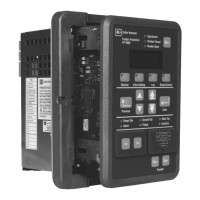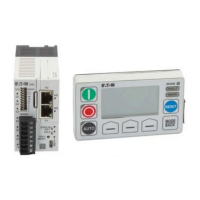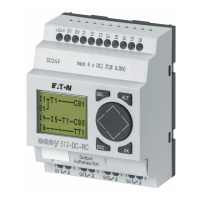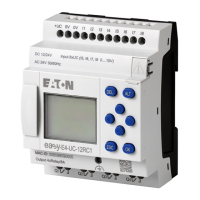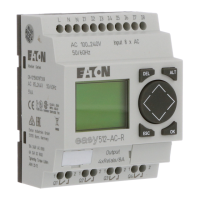Page 96 I.L. 17562
PR 0.3 Effective 8/99
mind that high-resistance or arcing faults, which may take a longer time to clear, have less
tendency to severely depress voltage than a solid fault.
9.1.10 Ground Fault Protection Application — Use this fault-protection function with a flux-
canceling ground fault Ct. This Ct has a large primary window through which all three phase
conductors can pass. The most common ground fault Cts have a ratio of 50:5 or 50:1.
The MP-3000 carries UL 1053, Ground Fault Protective Device listing. This may eliminate the
need for a separate ground fault protector in many applications that formerly required it.
Note that the ground fault trip and alarm current setpoints GFT, P3L1 and GFA, P4L1 are based
on percentage of ground Ct rated primary current, not on FLA or the phase ct ratio. For
example, setting 10% gives a trip or alarm for an actual ground leakage current of 5 A with a
50:5 Ct (GCT, P1L6 = 50).
Obviously, this function is only useful for a grounded power system – the ground return is
normally made from the neutral of the secondary wire winding of the supply power transformer.
Resistance grounding is acceptable, as long as the resulting fault current is at a level the relay
can be set to detect.
The ground ct, which provides sensitive protection for high-resistance ground faults, may
saturate for a robust heavy-current ground fault in a solidly grounded system. Minimize the
saturation problem by minimizing the burden - use the shortest and heaviest leads possible
between the ground Ct and the relay. The MP-3000 itself has very low burden, usually much
lower than the connecting wiring. Calculate the current magnitude which saturates the ground ct,
considering the ct secondary voltage capability; and the total burden of the ct secondary winding
itself, the connecting wires, and the relay. Make sure this saturation current is well above the
minimum sensitivity of the phase IOC function and/or the motor fuses.
Residual connection – wired summation of the phase Ct circuits through the ground Ct input –
requires a much higher GFT setting to avoid false tripping. Thus sensitivity is not nearly as good
as with a separate flux-canceling Ct. If the relay is installed where a residual connection is used,
GCT should be set to the same value as PCT. The user must then set the ground fault trip level
at a high value to avoid nuisance tripping from Ct ratio errors, third harmonic and certain higher
harmonics, or other measurement errors producing false residual currents. Monitor the metered
ground current during various loading conditions to insure good margin between these error
currents and the ground fault trip current setting GFT, P3L1. Also, watch out for phase Cts which
saturate during motor starting - the saturation will produce a large residual current and a ground
fault trip. This may be a problem if the Cts have low voltage capability (e.g. C5 or C10), or if
they have long wiring runs or are otherwise heavily burdened.
9.2 Motor Cycle Monitoring — This refers to the MP-3000 functions that monitor the motor
during periods of normal operation. Normal operation includes the start cycle, run cycle, and
stop cycle. Trips may occur at any time. The MP-3000 time-tags many critical changes of state
and stores them with supporting data in log books and history records.
The primary function of the MP-3000 is to alarm, and to trip and block the motor contactor for
faults and abnormal or dangerous operating conditions. It can also exercise some active control
of a normally functioning motor and/or its load. Active control functions include transition control
to full running voltage for a reduced-voltage starter as explained next; and process load
shedding to reduce overload as explained in 9.1.5 above. Others can be programmed by
assigning a particular internal MP-3000 measurement to a contact output with output relay
setpoints.
9.2.1 Start Cycle and Transition Tripping — Figure 9.6 shows an example of how the MP-
3000 reacts to a normal operating-cycle current profile. Initially, the motor is stopped and the
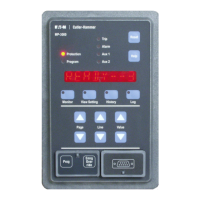
